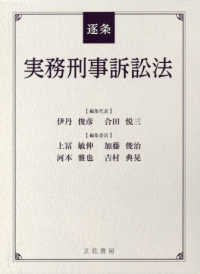- ホーム
- > 洋書
- > 英文書
- > History / World
Full Description
This volume contributes to the emerging topic of social paleoethnobotany with a series of papers exploring dynamic aspects of past social life, particularly the day-to-day practices and politics of procuring, preparing, and consuming plants. The contributors to this volume illustrate how one can bridge differences between the natural and social sciences through the more socially-focused interpretations of botanical datasets. The chapters in this volume draw on a diversity of plant-derived datasets, macrobotanical, microbotanical, and molecular, which contribute to general paleoethnobotanical practice today. They also carefully consider the contexts in which the plant remains were recovered. These studies illustrate that the richest interpretations come from projects that are able to consider the widest range of data types, particularly as they aim to move beyond simple descriptionsof food items and environmental settings.
The authors in this volume address several themes including: the collection of wild resources, the domestication of crops and spread of agriculture, the role of plant remains in questions regarding domestic life, ritual, and gender as well as the broader implications of a socially-engaged paleoethnobotany. These studies point a path forward for the constantly evolving field of paleoethnobotany, one that is methodologically rigorous and theoretically engaged. Together, these papers shed light on ways in which the specialized analysis of plant remains can contribute to theory building and advancing archaeological understanding of past lifeways.
Contents
Chapter 1. Social Paleoethnobotany: New contributions to Archaeological Theory and Practice (Maria Bruno and Matthew Sayre).- Chapter 2. Integrating archaeological data toward a better understanding of food plant choices and territory exploitation in the Northwestern European Early Neolithic: The case of Remicourt "En Bia Flo II" (Alexandre Chevalier and Dominique Bosquet).- Chapter 3. Cultigen Chenopods in the Americas: A Hemispherical Perspective (Gayle J. Fritz, Maria C. Bruno, BrieAnna S. Langlie, Bruce D. Smith, and Logan Kistler).- Chapter 4. Rethinking the Role of Wild Resources in Agriculturalist Societies: Archives from Rockshelter Cases of Northwestern Argentina (M. Alejandra Korstanje).- Chapter 5. Exploring Culinary Practices through GIS Modeling at Joya de Cerén, El Salvador (Alan Farahani, Katherine L. Chiou, Rob Q. Cuthrell, Anna Harkey, Shanti Morell-Hart, Christine A. Hastorf, and Payson D. Sheets).- Chapter 6 .Plant Use andthe Separation of Ritual and Domestic Space at Conchopata, Peru: A Middle Horizon Site (William Whitehead and Matthew Sayre).- Chapter 7. Ritual Time: The Struggle to Pinpoint the Temporality of Ritual Practice using Archaeobotanical Data (Christopher T. Morehart).- Chapter 8. A Compelling Intersectionality: Paleoethnobotany, Social Theory and Feminist Commitments (Margaret Conkey).- Chapter 9. Paleoethnobotany beyond Diet, Environment, and Ecology (Deborah Pearsall).







